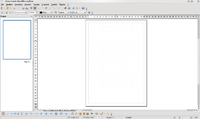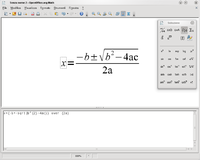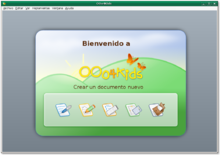Apache OpenOffice
Apache OpenOffice is an open source office software package, including word processor, spreadsheet, presentation, vector drawing tools, and database. It supports many file formats. file, including the standard ISO/IEC OpenDocument Format (ODF) as default, among other common formats, and focuses on maintaining compatibility with the OpenOffice XML standard, the Microsoft format, as well as supporting more than 110 languages, since February year 2010. Apache OpenOffice is one of the successors of the OpenOffice.org project and integrates features of other office suites such as IBM Lotus Symphony.
The office suite is available for various platforms, such as Microsoft Windows, GNU/Linux, BSD, Solaris and Mac OS X, as well as several ports made to other operating systems. The software is distributed under the Apache license.[5] The first version released by Apache was 3.4.0, on May 8, 2012. Since that first version, various forks have been made, such as for example LibreOffice (developed by The Document Foundation) and the Go-OO project, which was discontinued in favor of LibreOffice in September 2010.
Apache OpenOffice descends from OpenOffice.org, a project initially based on StarOffice, an office suite developed by StarDivision and acquired by Sun Microsystems in August 1999. Development of the suite was led by Sun Microsystems and with subsequently abandoned by Oracle Corporation. The application source code is available under the GNU Limited General Public License (LGPL) version 3 through version 3.4.0 Beta 1. After the Sun acquisition in 2010, Oracle Corporation stopped supporting commercial development and in June 2011, he donated the suite to the Apache Incubator to become a project of the Apache Software Foundation. Later, in December 2011, the Apache Software Foundation announced that the name of the project would become Apache OpenOffice.
The latest maintenance release was 4.1.12 on May 4, 2022. This update resolves some issues with bug fixes and updated dictionaries.
Applications included
The applications included in the Apache OpenOffice office suite are the following:
Fonts included
OpenOffice natively includes several fonts to be used as an alternative to Microsoft fonts (Calibri, Arial, Times New Roman), which are, among others:
- OpenSymbol
- DejaVu
- The sources of Gentium
- The source of Chrome OS Arimo (sans serif)
- Tinos (serif)
- Cuisine (monospace)
Programming/Scripting Languages
Apache OpenOffice incorporates OpenOffice Basic, an interpreted programming language very similar to the Microsoft Visual Basic for Applications (VBA) macro language. Apache OpenOffice provides limited support for macros written in Microsoft VBA. Macros written in OpenOffice Basic can be used in Writer, Calc, and Base.
Market share
OpenOffice.org and StarOffice claim 14% of the large business market in 2004. The website reported more than 100 million downloads.
OpenOffice.org has been adopted by a large number of institutions in the public and private sectors. Some of the reasons for its adoption are the rationing of the cost of software licenses and the use made by the suite of file formats. standard and independent files from a single supplier. OpenOffice.org users include the Singapore Ministry of Defense, Bristol City Council, Zaragoza City Council, Castellón de la Plana City Council and the French Gendarmerie.
On October 4, 2005, Sun and Google announced a strategic alliance whereby Sun would add a Google search bar to OpenOffice.org, Sun and Google would collaborate on common research and development and marketing activities, and Google would help distribute OpenOffice.org. In Mexico, OpenOffice.org is included in the YooBook computer. OpenOffice.org is usually pre-installed in many Linux distributions.
Criticism
The vast majority of the features that were criticized have been fixed in version 3. Some of the shortcomings that were criticized in older 2.x versions were the lack of built-in templates and automated wizards (there are many templates that can be downloaded from the Internet, although there are still relatively few that are translated into Spanish); limited ability to customize graphs (however, it was the main concern of version 2.4, which improved this problem) and lack of a multivariate solver in Calc.
Fast startup of old versions
Some users experienced slow startup when OpenOffice.org was first launched in versions prior to 3.0. This can be greatly improved, if you wish to continue using older versions, by changing OpenOffice.org's memory management settings. These changes allow OpenOffice to start much faster, at the cost of increasing memory consumption. Another possibility is to use the quick start program, an application that runs when the OS starts up, and that loads part of the software necessary for OpenOffice. This slows down the computer booting, but makes OpenOffice boot much faster.
About patents
Microsoft's head of licenses said during an interview with Fortune magazine in 2007 that his company is harmed by free programs that would violate 235 patents owned by him. OpenOffice.org would be violating 45 Microsoft patents. In any case, Microsoft has not disclosed what those patents are, although it may have the OpenOffice.org source code for inspection. This action was interpreted by many people as Microsoft's FUD in order to discourage the use of OpenOffice.org and free software. One point to consider is that many countries do not allow the granting of patents to computer programs, so in them, if this complaint is made, it would not be relevant.
Applications derived from OpenOffice.org
There are several office suites derived from OpenOffice.org. Most of them are developed under the SISSL license (which is valid up to OpenOffice.org 2.0 beta). In general, its target is the local market, with proprietary additions like a speech recognition module, automatic database connection and better CJK support. One such derivative is the proprietary Lotus Symphony office suite. Another derivative application is NeoOffice for Mac. The Mac version of OpenOffice 3 is fully integrated into that environment.
StarOffice
Sun Microsystems helps develop OpenOffice.org and uses it as the basis for developing its own commercial version called StarOffice. Versions of StarOffice since 6.0 have been based on the OpenOffice.org source code. The difference between the two suites is that StarOffice includes some additional proprietary components, such as additional fonts (especially Asian language fonts); additional document templates; additional file filters and migration tools (Enterprise Edition).
Go-OO
Go-OO is a fork of OOo that develops a set of patches that fix bugs and add functionality to the office suite. OpenOffice and the fixes made by the Go-OO project are included in several Linux distributions, including Debian, Mandriva, openSUSE, Gentoo and Ubuntu.
LibreOffice
After the acquisition of Sun Microsystems (sponsor of the development of OpenOffice.org) by Oracle, StarOffice and StarSuite were renamed Oracle Open Office.
On September 28, 2010, members of the OpenOffice.org project development community formed a new group called The Document Foundation, making available a fork of OpenOffice.org called LibreOffice. The foundation stated that it will coordinate and monitor the development of LibreOffice. Oracle was invited to become a member of The Document Foundation and asked to donate the OpenOffice.org brand to the project. The Document Foundation received support from the independent Open Office developer community, as well as from Novell, RedHat, Canonical, and Google. The objective is to produce an office suite independent of any company, with ODF support and without the obligation to assign the authorship of the code to Oracle. Oracle Open Office requires that the authorship of the code be assigned to Oracle (previously the obligation was Sun).
Contenido relacionado
Harvard Mark I
MediaWiki:Watcheditlist
Konqueror






